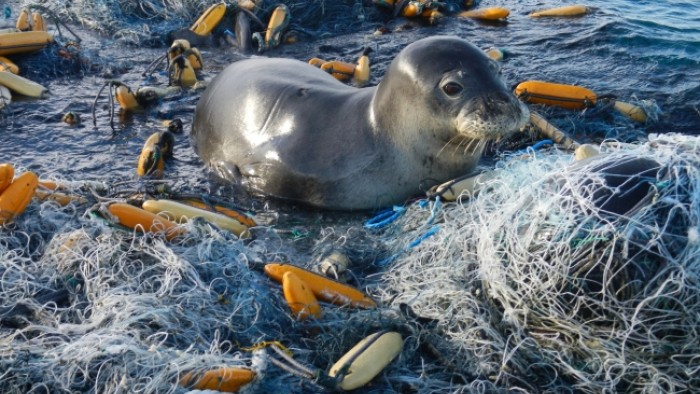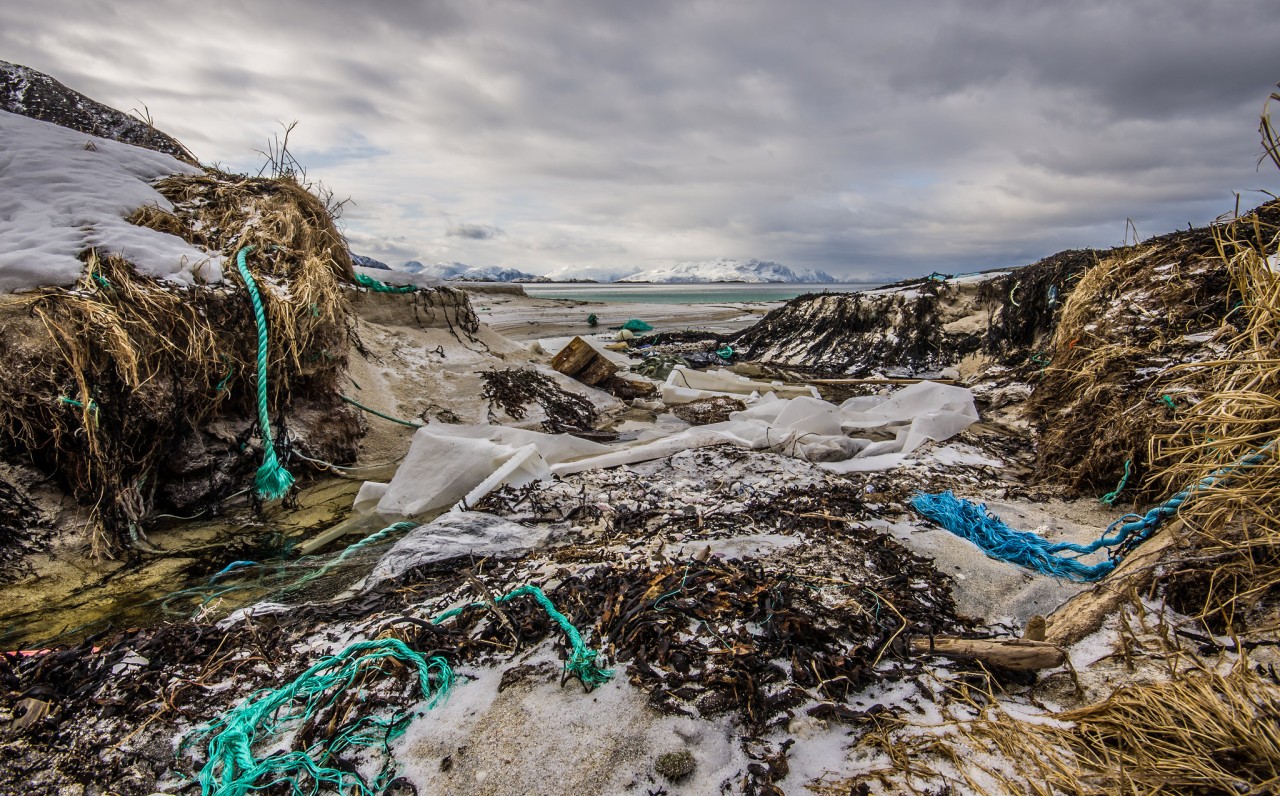Financing the Battle Against Marine Plastic Pollution

In Brief
The plastic industry has seen tremendous growth over the past 50 years. According to the MacArthur Foundation, production has increased from 15 million tons in the 1960s to 311 million tons in 2014, and is projected to double again over the next 20 years.
Investors have hesitated to tackle this problem for multiple reasons. “Prime among them is a ‘missing middle’ of investible entities that demonstrate a track record of profitability and growth,” according to Circulate Capital's "Handbook for Action" on marine plastics.
Both private and public investments could help tackle the problem by boosting the economic value of waste materials and improving the efficiency of waste collection, processing and disposal.
*August 2023 metric update: More recent data shows that every year between 8 to 10 million tons of plastic end up in the ocean, according to UNESCO Intergovernmental Oceanographic Commission.
Experts predict that, by weight, there will be more plastic than fish in the world’s oceans by 2050. A 2016 report from the Ellen MacArthur Foundation estimates that at least 8 million tons of plastic end up in the ocean each year. That amount is equivalent to unloading “one garbage truck into the ocean every minute,” the MacArthur Foundation calculated. Pollution could grow to the equivalent of two trucks per minute by 2030 and four per minute by 2050 if mitigation efforts do not intensify.
The plastic industry has seen tremendous growth over the past 50 years. According to the MacArthur Foundation, production has increased from 15 million tons in the 1960s to 311 million tons in 2014, and is projected to double again over the next 20 years. Twenty-six percent of that production goes towards plastic packaging. Because packaging relies on single-use plastics, the economy loses $80-120 billion worth of plastic packaging value each year.
Only 14% of plastic packaging is recycled, and by the time it is processed, only 5% of material value is available for reuse.
“A majority of the 8 million metric tons of plastic entering the ocean every year leaks from just a few countries in Asia where trash collection and recycling systems have not kept up with growing populations and economies,” wrote Ocean Conservancy CEO Janis Searles Jones in a 2019 report.*
About half of land-based plastic waste comes from China, the Philippines, Indonesia and Vietnam, and the rest from other developing countries in Asia, Africa and Latin America. The lack of established waste management processes in these countries harms marine life, sea transport, fisheries, tourism and ecosystems, according to the United Nations Environment Programme. Additionally, because plastic debris breaks down slowly, it has the ability to damage the environment over long periods of time.
With the health of ocean ecosystems threatened by marine plastic pollution, what opportunities are there for private capital to become part of the solution?
Barriers to Financing
“The threats to the ocean are well documented,” Marco Lambertini, director general of WWF International, wrote in a 2015 report analyzing the economic value of the world's oceans. “Even the solutions are fairly well known. It is political and corporate will that remain elusive. We continue to take the ocean for granted, perhaps because the poor communities that are most dependent on ocean resources lack power and influence, and turtles do not vote.”
Additionally, as Circulate Capital (an investment management firm working to prevent plastics from entering into the ocean) states in their 2019 “Handbook for Action” on plastic pollution, investors have hesitated to tackle this problem for multiple reasons. “Prime among them is a ‘missing middle’ of investible entities that demonstrate a track record of profitability and growth,” the handbook states, meaning that prospective investors do not have well-established examples on which to base their decisions.
To address these issues, Vulcan Inc. (which manages projects started by late Microsoft cofounder Paul G. Allen) and Encourage Capital (an asset management firm focused on social and environmental challenges) have developed an investment framework aimed to simultaneously reduce oceanic plastic waste pollution and promote sustainable development.
The groups argue that the problem in major plastic waste source countries is that the amount that waste can generate in revenue is less than what it costs to collect it. A focus area for the two groups is therefore integrated waste management investment in key plastic waste source countries.
Can Innovative Investments Decrease Plastic Pollution?
Vulcan and Encourage Capital suggest two ways that both private and public investments could help tackle the revenue problem. First, to create more incentive to collect plastic waste, stakeholders — such as governments, municipalities, waste managers and investors — should help boost the economic value of waste materials. Secondly, stakeholders should look to vertically integrate the waste management process in order to improve the efficiency of waste collection, processing and disposal. This increased efficiency could allow for better value within the waste management chain, and therefore greater ability for businesses to divert waste before it reaches the sea.
While private investments may not entirely solve the problem without government and philanthropic aid, they have the potential for significant impact. Vulcan and Encourage Capital propose several private investment options for taking on marine plastic pollution. In low- and middle-income nations, investors should focus on project or debt investments in waste management companies. In plastic waste source countries, Vulcan and Encourage advocate private equity or venture investments in companies that aim to vertically integrate waste management operations as well as in firms focused on specific waste management problems. And if interested investors aren’t looking to invest in a specific waste management company, they can provide private equity or venture funds to support tech companies that are researching ways to make “waste to value” technologies more effective.
The Ocean Conservancy and McKinsey & Co. argue that private investment in marine plastic issues will expand once the right project-finance structures and risk-management tools — such bond financing — are more widely available.
International corporations can play a role in attracting these private investors through “derisking” mechanisms, such as “first-loss insurance pools, equity partnerships with multilateral lenders and equity providers, and market-entry supports for US and European waste-technology providers,” according to the Ocean Conservancy and McKinsey. For example, the groups highlight the Closed Loop Fund as a model, an effort launched by a group of companies in 2014 to provide below-market-rate loans for recycling infrastructure in the United States. Such efforts promise to reduce capital costs and investment risks, making the plastic waste reduction investment space more attractive.
Some groups are also working to build models for financing marine plastic pollution prevention. In 2018, Circulate Capital worked with the Ocean Conservancy to attract over $100 million in commitments to develop a funding mechanism that aims “to blend concessionary and philanthropic monies with market rate investment capital to unlock institutional funding” for waste collection, according to their handbook. By creating this mechanism and sharing investment strategies with the public, the two groups are hoping to demonstrate that investments in plastic waste recovery can generate profit. This project could encourage participation of interested investors by showing them that their investments can be beneficial to both the environment and themselves.
In addition to investments, data, connectivity and strategic storytelling may also have a role in mitigating the ocean plastic pollution problem. The 2019 Ocean Plastics Leadership Summit, an event that convened corporate executives, NGOs, scientists and industry experts, presented a series of ideas. Some of these suggestions included designing open databases to share costs and returns from companies switching to reusable plastics, creating a portal to streamline how start-ups and entrepreneurs committed to the space can engage with potential investors, and developing a new financing structure to help restaurants and food services eliminate single use plastic products. The summit also focused on the need for powerful storytelling to unite investors with other stakeholders, according to event proceedings.
A Thriving Ocean
According to WWF, the ocean would have the world’s seventh-largest economy with an annual “gross marine product” of at least $2.5 trillion if it were a country.
This calculation does not factor in benefits from the ocean such as climate regulation and oxygen production that cannot be easily quantified. It also does not include the spiritual and cultural value that many people find in the ocean or factor in elements such as global biodiversity.
Over two-thirds of the economic value that comes from the ocean each year depends on a healthy marine environment, and the increasing need for marine resources and food parallels the growth of human population. Marine plastics risk destroying delicate and complex ecosystems, threatening the wild creatures that sustain themselves on the ocean’s natural resources.
The future of the marine plastic pollution problem does not just depend on private capital. The issue calls for philanthropy, citizen engagement, government action and more to mitigate the problem collaboratively.
“We have a major challenge ahead,” wrote Inger Anderson, Director General of the International Union for Conservation of Nature in a 2017 report. “But with a collaborative global effort, we can reverse the grim forecasts for plastic pollution, and return to a world with healthy oceans.”
To comment on this article, please post in our LinkedIn group, contact us on Twitter, or use our contact form.
